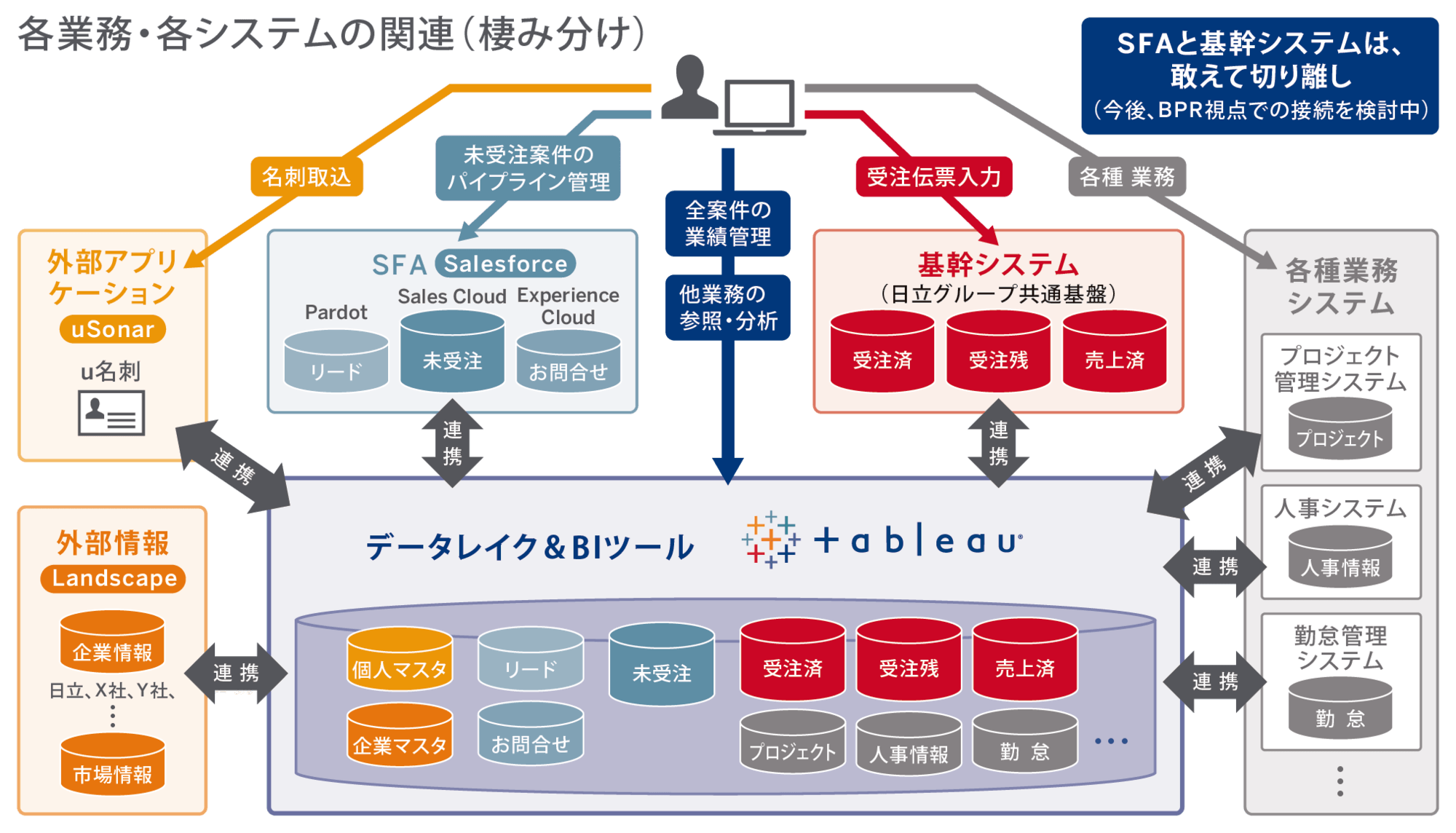

Utilizing Tableau as Essential Infrastructure Enabling Management Visualization and Process Reforms through SFA
Performance meetings for the Sales Department reduced to 2/3, while performance meetings have been eliminated for the Inside Sales Department
Streamlined operations to reduce costs by four times investment, including SFA, in the first fiscal year alone
Background to Implementation
Building a Data Utilization Platform for the Essence of SFA
It’s a feeling shared by an increasing number of managers: “I want to make active use of data to reform sales processes and visualize the management of the business.” Hitachi Solutions, Ltd. actively utilizes SFA to that end and continues to steadily produce results.
Hitachi Solutions plays a central role in the IT sector at the Hitachi Group. Through the information and telecommunications systems business, Hitachi Solutions provides a variety of global solutions that support social lifestyles and business activities. The company has four offices within Japan and eight more overseas. Adding in its five Hitachi Solutions Group subsidiaries, the company has over 12,000 employees globally. Kazuo Hata, General Manager of the 1st Inside Sales Department in the Sales Operations Division of Hitachi Solutions, reflects on their past business activities as follows.
“In the past, we had a lot of meetings for the sake of having meetings. The sales forecasts reported at those meetings were kept within 99-101% of a predetermined budget. The corporate culture was such that business realities were not easily presented up front. For that reason, it was difficult to determine the extent to which certain projects were active and their incoming order acceptance rate, making it difficult to predict sales and earnings.” To resolve these issues, the company decided on a “full restructuring of SFA” in May 2017. Alongside this, the company also began building data lakes and a BI platform.
“The term SFA contains the word ‘sales,’ and the core idea there is that all personnel input data that is then used for business management purposes. In other words, this is a management tool, so I felt that if a data utilization platform is not set up alongside the tool, it will be impossible to derive much benefit from it.”
The core idea of SFA is that all personnel input data that is then used for business management purposes. In other words, this is a management tool, so I felt that if a data utilization platform is not set up alongside the tool, it will be impossible to derive much benefit from it.
Tableau Implementation and Operation
Implementing Tableau to Reduce the Workload of Data Aggregation and Analysis
“We were actually considering internal data lakes as a separate project from the full restructuring of SFA,” said Takafumi Kosaka, Group Manager of the 1st Group, Operational Reforms and Digitalization Promotion Center at IT/DX Promotion HQ at Hitachi Solutions. The Hitachi Group was integrating operations across the Group as a whole by transitioning away from individual company-specific systems to a shared system provided by the Group. Kosaka explains that this change made it impossible to have free control over data the way that companies did with their company-specific systems, so there were issues to resolve with respect to user operations and inefficiency. “Resolving these issues required internal company data lakes and data usage, which immediately catalyzed initiatives aimed at bringing those things about.”
The first stage of data utilization was the provision of raw data in CSV format. The second stage was the provision of processed data that incorporated user needs. However, similar aggregation/analysis work was performed in each respective user department, creating more of a workload than was necessary.
“To resolve these issues, in January 2018 we began to look at the possibility of introducing BI products as a data usage platform for the entire company,” said Aki Shirako, Senior Staff of 1st Group, Operational Reforms and Digitalization Promotion Center at IT/DX Promotion HQ at Hitachi Solutions. It was here, he said, that Tableau was raised as a possible solution. Ultimately, Tableau was adopted as the company-wide BI platform.
System changes took away free control over data, and this prompted a need for internal company data lakes and data utilization, immediately catalyzing relevant initiatives
Why Tableau?
Easy to Achieve Self-Service BI
So why did Hitachi Solutions ultimately select Tableau? Shirako gives three main reasons.
The first reason is how easy it is to read Tableau dashboards. He said the dashboards were well-liked because they are bright, simple, and polished. Second, the dashboards are easy for users to customize, making it easy to achieve self-service BI. The IT Department has limited access to personnel, so it is difficult for it to maintain all content (e.g. dashboards, reports). And since there is no limit on how much user data needs will crop up based on changes in businesses and circumstances handled by specific departments, they considered the feasibility of self-service BI to be a hard requirement. “Tableau has intuitive user controls, and users can create their own dashboards just by referencing videos available online. I felt that these factors meant self-service BI was possible.”
Third, Tableau enables you to start small. Licenses are subscription-based rather than single-purchase, making it easy to start using the service with low initial cost. Hitachi Solutions began with 25 licenses as a trial phase, then increased to 150 licenses six months later. The company then increased the relevant budget the next fiscal year, suddenly acquiring a large number of licenses. The ease with which users can decide to increase their number of licenses while still using the service was another big benefit of Tableau.

Tableau has intuitive user controls, and users can create their own dashboards just by referencing videos available online. I felt that these factors meant self-service BI was possible.
Benefits of Tableau Implementation
Streamlined Operations with an Established Data-Usage Culture
Adopting Tableau as the company’s BI platform yielded the following types of benefits.
SFA-registered cases totaling over three times budget
“When we first started working on the full restructuring of SFA, we aimed to have the total volume of SFA cases exceed 200% of the budget by March 2020,” said Hata. In reality, SFA-registered cases reached 315% of the budget, marking what Hata says was a fundamental transformation of a company culture that only allowed “99 to 101% of budget to be presented up front.” “As a result, we are able to make fine-tuned predictions regarding how many leads exist at a given point in time and how sales will shift on that basis.”
SFA usage spreading even outside of sales
Although SFA was initially used only by the Sales Department, it currently has many users even outside of the Sales Department, with license numbers tripling over a four-year period. SFA is steadily becoming established in its core role as the “management tool for the entire company.”
Reducing time spent in meetings
As of March 2020, Sales Department meetings had been reduced to two-thirds. In the Inside Sales Department, which Hata leads, zero performance meetings had been held as of the end of March 2021.
Cost reduction benefits
The streamlining of operations has also helped to reduce costs. In the first fiscal year of implementation alone, those cost reductions totaled four times investment, including SFA.。
Improvements to business performance
Performance has improved throughout the company since Tableau was first introduced. In the recently established Inside Sales Department, business results have reached 355% of previous-year levels. All of this is believed to be due to a virtuous cycle in which the reduction in unnecessary meetings has led to an increase in opportunities for business discussions with customers.
Future Developments
Providing Customers with the Company’s Accumulated Knowledge and Expertise
Hitachi Solutions’ current objective is to incorporate all business activities into dashboards by 2027 and enable all staff members to share and utilize them. The company is also aiming to eliminate all performance meetings and conduct company management using real-time data.。
In this way, Hitachi Solutions is in the process of achieving a type of company management that makes use of all data input by all company personnel. This is truly thanks to DX, and the findings derived from this experience are being passed along to Hitachi Solutions’ customers.
“Hitachi Solutions has been working for many years to provide the latest technologies alongside solutions that are flexible combinations of various products and services,” said Ryosuke Suzuki, Chief Engineer of the 2nd Cross-Market Services Group, Cross-Market Services HQ at Hitachi Solutions. Additionally, the company’s data usage business has existed for over 20 years, and in 2019 it formed a business alliance with Tableau.。
One specific DX-related solution offered by the company based on that expertise and that alliance is its “BI concierge service.” This service helps customers set up data-powered systems by helping them create roadmaps and organize issues along the way, then provides assistance with implementation and improvement of the system itself, as well as with data usage and the establishment of data usage practices at the customer’s company. This service enables customers to draw on others’ expertise and experience to take the shortest possible route to DX promotion that will have a positive impact on their company’s business management.
“The key to making DX succeed is how to best utilize the untapped goldmine of underutilized data,” said Suzuki. The Hitachi Group has over 30,000 Tableau users and has implemented Tableau for customers on over 100 sites, winning the company the Partner Award for both 2021 and 2022. “Drawing on these accomplishments and this expertise, we hope to continue helping our customers utilize Tableau and achieve DX in the future.”
The key to making DX succeed is how to best utilize the untapped goldmine of underutilized data.



